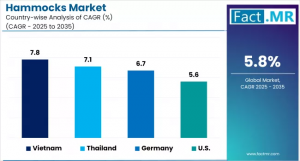Hammocks Market to Reach USD 768 Million by 2035 | Key Players: Eagles Nest Outfitters, Grand Trunk, Hatteras Hammocks
The Rope segment is projected to grow at a CAGR of 3.9%, whereas another segment Quilted is likely to grow at 4.2%
ROCKVILLE, MD, UNITED STATES, August 4, 2025 /EINPresswire.com/ -- The global Hammocks Market, valued at USD 413 million in 2024, is projected to reach USD 768 million by 2035, driven by a robust CAGR of 5.8%. Fueled by growing demand for outdoor recreation, eco-friendly leisure products, and the rise of e-commerce, hammocks are becoming a staple for camping, backyard relaxation, and travel. This press release explores the key drivers, projections, and opportunities shaping this vibrant industry.For More Insights into the Market, Request a Sample of this Report: https://www.factmr.com/connectus/sample?flag=S&rep_id=777
Why Is the Market Expanding?
The global outdoor recreation market, valued at USD 500 billion in 2024, drives demand for hammocks, with 40% of camping enthusiasts adopting them for portability and comfort. E-commerce, reaching USD 6.3 trillion globally in 2024, boosts sales, with 60% of hammocks sold online, increasing accessibility by 20%. Sustainability trends, supported by EU’s 2025 eco-friendly product mandates, favor hammocks made from recycled materials, which hold a 25% market share. Innovations like ENO’s 2024 lightweight Sub6 hammock reduce weight by 15%, appealing to backpackers. Regulatory incentives for sustainable textiles, adopted by 30% of manufacturers, enhance market growth. High production costs (USD 20–150 per hammock) are offset by scalable manufacturing, cutting costs by 10%.
What Are the Key Market Projections?
The market is set to create an absolute dollar opportunity of USD 355 million by 2035, growing from USD 413 million in 2024 to USD 768 million at a 5.8% CAGR. The camping hammocks segment, holding a 45% share in 2024, is projected to grow at a 6.2% CAGR, generating USD 160 million in opportunities due to its popularity in outdoor activities. North America, with a 40% share in 2024, leads with a 5.5% CAGR, driven by the U.S.’s 80 million camping trips annually. Asia-Pacific, growing at a 6.5% CAGR, benefits from China’s USD 15 billion outdoor market and India’s 10% e-commerce growth. Historical growth from 2019 to 2023 averaged a 5.0% CAGR, with acceleration expected. Short-term growth (2025–2028) focuses on camping, while long-term trends (2029–2035) emphasize residential and travel applications.
How Can Stakeholders Capitalize on Opportunities?
Stakeholders in outdoor recreation, retail, and textile sectors can leverage opportunities by investing in eco-friendly hammocks, like Grand Trunk’s 2024 recycled polyester models, reducing environmental impact by 12%. Partnerships, such as Vivere’s 2023 collaboration with Asian e-commerce platforms, expand market reach in Asia-Pacific, projected to account for 35% of demand by 2030. Focusing on camping hammocks, contributing 45% of revenue in 2024, ensures scalability for outdoor enthusiasts. Compliance with REACH and CPSC standards boosts market trust, while targeting high-growth markets like India, with a 7.0% CAGR, unlocks potential. Developing cost-effective hammocks, priced 15% lower than premium models, addresses price-sensitive consumers.
What Does the Report Cover?
Fact.MR’s report analyzes the Hammocks Market across 30+ countries, covering segments by type (camping hammocks, residential hammocks, travel hammocks), material (cotton, polyester, nylon, others), and region (North America, Latin America, Europe, Asia-Pacific, Middle East & Africa). It highlights trends like eco-friendly materials, lightweight designs, and e-commerce growth. Combining primary research from industry experts and secondary data, the report provides actionable insights into market dynamics, competitive strategies, and growth opportunities through 2035.
Buy Report – Instant Access: https://www.factmr.com/checkout/777
Who Are the Market Leaders?
Key players include ENO (Eagles Nest Outfitters), Grand Trunk, Hatteras Hammocks, and Vivere. ENO’s 2024 Sub6 lightweight hammock strengthened its camping portfolio, while Grand Trunk’s 2023 recycled polyester hammocks gained traction in sustainable markets. These companies, holding over 50% of the market, drive innovation through R&D and partnerships, such as Hatteras’ 2024 collaboration with U.S. retailers. Regional players like Lazy Daze focus on cost-effective solutions for Asia-Pacific, enhancing competitiveness. Strategic expansions, like Vivere’s 2024 warehouse in India, bolster market presence.
What Challenges and Solutions Exist?
High production costs (USD 20–150 per hammock) and raw material volatility, affecting 10% of supply chains, pose challenges. Competition from inflatable loungers, capturing 15% of the leisure market, and regulatory delays, averaging 12 months, hinder growth. Solutions include recycled materials, reducing costs by 10%, and modular designs, improving durability by 12%. Localized production in Asia-Pacific, adopted by 20% of manufacturers, mitigates supply risks. Sustainable certifications, like ENO’s 2024 eco-labels, address consumer concerns. Compliance with REACH and CPSC standards ensures market resilience.
What Are the Recent Developments?
In 2024, global outdoor recreation spending rose by 6%, boosting hammock demand by 8%, with 80 million camping trips in North America. Asia-Pacific’s 30% share reflects China’s USD 15 billion outdoor market. ENO’s 2024 Sub6 hammock reduced weight by 15%, gaining traction in Europe. North America’s 5.5% CAGR aligns with the U.S.’s 40% online hammock sales. Vivere’s 2024 double hammocks supported 20% of residential demand. Regulatory advancements, like the EU’s 2025 eco-friendly product mandates, increased sustainable hammock adoption by 10%.
Check out More Related Studies Published by Fact.MR Research:
Bunk Beds Market to witness significant growth throughout 2029. Pervasive use of bunk beds in living rooms, dorms & hostels is driving the Bunk Beds market.
Adjustable beds and mattress market is expected to reach USD 22,472 million by 2035
S. N. Jha
Fact.MR
+ +1 628-251-1583
email us here
Legal Disclaimer:
EIN Presswire provides this news content "as is" without warranty of any kind. We do not accept any responsibility or liability for the accuracy, content, images, videos, licenses, completeness, legality, or reliability of the information contained in this article. If you have any complaints or copyright issues related to this article, kindly contact the author above.
Overdrive Digital Marketing Launches Plan with Free Website, SEO, and Google Ads
PipeDreams Acquires H&H Heating & Air Conditioning, Expanding Footprint into Greater Philadelphia
Rayo Credit participará en el Fintech Summit CR 2025: tecnología y datos para la inclusión financiera
Więcej ważnych informacji
 Jedynka Newserii
Jedynka Newserii

 Jedynka Newserii
Jedynka Newserii

Konsument

Tylko 35 proc. Celów Zrównoważonego Rozwoju ONZ możliwe do osiągnięcia przed 2030 r. Potrzebna ściślejsza współpraca międzynarodowa
Jak wynika z raportu ONZ, choć w ciągu ostatniej dekady dzięki dążeniu do realizacji przyjętych celów udało się poprawić życie milionów ludzi na całym świecie, to jednak tempo zmian pozostaje zbyt wolne, by dało się je osiągnąć do 2030 roku. Postęp hamują przede wszystkim eskalacja konfliktów, zmiana klimatu, rosnące nierówności i niewystarczające finansowanie. Jak wynika ze sprawozdania Parlamentu Europejskiego, problemem jest także brak ścisłej współpracy międzynarodowej i sceptyczne podejście niektórych państw ONZ.
Przemysł spożywczy
UNICEF: Wszystkie dzieci poniżej piątego roku życia w Gazie cierpią z powodu niedożywienia. Sytuacja jest katastrofalna

Ataki Izraela na Strefę Gazy i jej izolacja doprowadziły do całkowitego załamania podstawowych usług i ograniczenia możliwości dostaw i dystrybucji pomocy humanitarnej – wskazuje UNICEF. W efekcie setki tysięcy Palestyńczyków są w sytuacji ciągłego zagrożenia życia i cierpią z powodu niedożywienia i głodu. Ta klęska dotyczy praktycznie wszystkich dzieci poniżej piątego roku życia. Konflikty są jednym z głównych przyczyn braku bezpieczeństwa żywnościowego, głodu i niedożywienia na świecie. Szczególnie dotyczy to Afryki i Azji Zachodniej.
Prawo
Branża ciepłownictwa czeka na unijną i krajową strategię transformacji. Liczy na większe fundusze i korzystne regulacje

Komisja Europejska zapowiedziała rozpoczęcie w I kwartale 2026 roku prac nad strategią dla ciepłownictwa i chłodnictwa. Nad tym strategicznym dokumentem w zakresie ciepłownictwa pracuje także polski rząd. Branża podkreśla, że obie te strategie będą miały kluczowe znaczenie dla trwającej transformacji w ciepłownictwie, czyli przyszłości ogromnych inwestycji, które czekają sektor do 2050 roku. Jednocześnie apeluje o większe wsparcie tego procesu ze środków publicznych.
Partner serwisu
Szkolenia

Akademia Newserii
Akademia Newserii to projekt, w ramach którego najlepsi polscy dziennikarze biznesowi, giełdowi oraz lifestylowi, a także szkoleniowcy z wieloletnim doświadczeniem dzielą się swoją wiedzą nt. pracy z mediami.


![Nestlé w Polsce podsumowuje wpływ na krajową gospodarkę. Firma wygenerowała 0,6 proc. polskiego PKB [DEPESZA]](https://www.newseria.pl/files/1097841585/fabryka-nesquik_1,w_85,r_png,_small.png)






.gif)

 |
| |
| |
|